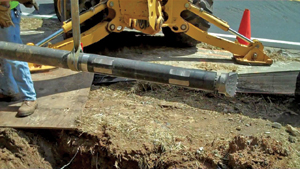Meeting Rock Drillers’ Needs: DTH Percussive Hammers
 The down-the-hole (DTH) percussive directional rock drilling market is a fast growing market, particularly in the Southeastern United States due to the extremely abrasive igneous type rock found in the region. A method to get through the rock was something that was lacking in the early days of directional drilling.
The down-the-hole (DTH) percussive directional rock drilling market is a fast growing market, particularly in the Southeastern United States due to the extremely abrasive igneous type rock found in the region. A method to get through the rock was something that was lacking in the early days of directional drilling.
It used to be a common misconception that a percussive hammer was not a proven method for directional rock drilling. Well, those days are gone. There have been thousands of rock bores completed using this method, and a wave of companies are hitting the market every year with a steerable percussive system that can be attached to just about any directional drill.
What makes these systems unique is that the air conversion usually takes place in the field in about 30 minutes. A basic system consists of a carbide button bit, a down-the-hole hammer, bent sub, a special sonde housing designed to absorb vibration and a support station. The support station is set up between the air compressor and the drill and has three functions: 1.) Turn air on/off; 2.) Inject water into a high pressure air stream for sonde cooling and keeping dust down; and 3.) Oil injection system for lubricating the piston in the hammer.
To best understand how DTH evolved, it would be beneficial to have a basic knowledge of the other two methods of drilling rock.
Rotary Drilling
Whether it is a mechanical rotational motor turning the drill bit or fluid gallons per minute, rotary drills drilling vertical and horizontal rely on high rotational speed and high thrust/torque to penetrate the rock. The harder the rock the greater the thrust is required to get the same effect.
Drifter Percussive Drilling
These drills do not rely on high thrust or high torque for the cutting action. They operate from percussive energy that comes from a hammering action from the carriage and is transmitted through the drill string to a button carbide bit that is engaged into the rock. They pass low pressure air through the drill string to remove the cuttings. This method is good for short holes because the deeper they drill the farther the percussive energy must travel to engage the bit. These are the drills that helped build our great interstate system, and we’ve all seen their handy work in the pre split rock walls they leave behind.
DTH Percussive Hammer
Unlike the drifter drill, the DTH hammering action only takes place at the end of the drill string, with little loss of energy. As the high-pressure air passes through the hammer with the button bit pressed against the face of the rock, the piston will hit the back of the bit forcing the bit into the rock. The air then passes through the end of the bit removing the rock cuttings back through the bore hole to atmospheric air pressure. DTH is unique in that the more air pressure the hammer can hold, the faster the penetration rate. Most DTH hammers on the market today will hit anywhere from 1,600 to 2,300 beats per minute (bpm) at 350 psi 900 CFM, and most can steer in rock or dirt. They do not require much thrust or rotational torque for the hammer to work, and you do not have to anchor the drill. You need just enough thrust to keep up with the production rate of the bit, and they only use one to four gallons of water per minute.
We think of the air compressor like a fire hydrant — a continuous supply of water that you never have to go get or clean up.
Cary Cooper is owner of Hardrock HDDP Inc., which is based in Atlanta.
Case Study — Robert Bilida, President of CCD Energy Services
During summer 2005, CCD Energy Services began to evaluate alternative HDD methods for the installation of oil and gas pipelines in environmentally sensitive areas. When we began our study, the only method for rock boring involved the use of a mud motor and the related risks associated with an uncontrolled release of drilling fluid.
CCD Energy Services recognized the need to find a better solution for HDD rock drilling that mitigated the environmental risks. Since then, we have developed and implemented a series of processes and procedures that meet our environmental goals. Of the various procedures that have been developed, the most significant improvement incorporates the use of a compressed air-driven percussion hammer to bore through rock formations. Our experience to date has shown that our air drilling methods greatly reduces the environmental risk when attempting difficult and highly fractured rock bores.
Air drilling uses large volumes of air instead of large volumes of drilling mud to power the drill head and to extract the cuttings. Using air instead of drilling mud eliminates the severity of a frac-out. If a frac occurs with air, the containment can often be done with a shovel and a few sand bags. Drills which encounter combinations of soft and hard formation, with the related loss of circulation, greatly lend themselves to air drilling.
CCD Energy Services recently completed two environmentally sensitive crossings across the West Kiskatinaw River near Dawson Creek in British Columbia, Canada. These crossings provided the opportunity to demonstrate our air drilling techniques. Some of the numerous challenges included: limited access, shortened bore length, shallow no-drill zone, extreme cold weather, and three quarters of the bore length required accurate steering. In addition, the bore encountered combinations of clay, sandstone, shale layers and a hydraulic aquifer connection to the river. During the drill, we were constantly monitoring the river since the drill path went under a trout spawning area and was the water supply for Dawson Creek. We had visits from Department of Fisheries and Ocean, Oil and Gas Commission and B.C. Ministry of the Environment. Since air drilling is new to these regulatory agencies we were under the highest scrutiny.
We completed the project with great success and now have the endorsement of all these government agencies in regards to environmental air drilling.
![]()




